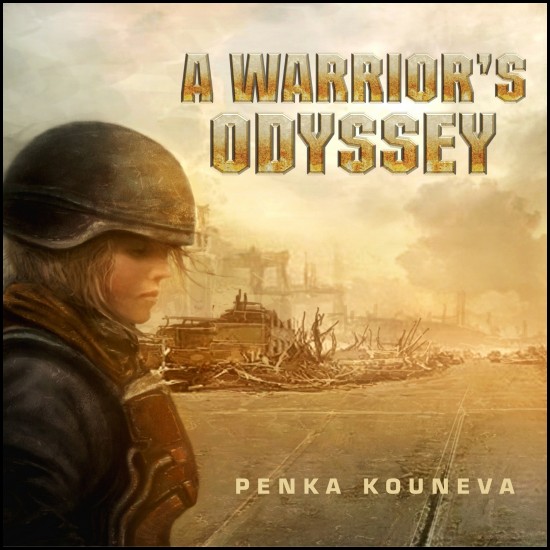Purchase CD – Howlin’ Wolf Records [2]
Purchase Digital – Amazon MP3 [3] | iTunes [4]
Bulgarian-born composer Penka Kouneva [5] is a recent member of the game music community, but she’s been doing film and television score for much longer. Her game credits include co-composing Prince of Persia: The Forgotten Sands with Steve Jablonsky, doing arrangements for the Gears of War games and most recently arrangement for World of Warcraft: Mists of Pandaria. She also had an original composition featured on the charity album Play for Japan [6].
Recently, Ms. Kouneva released an original album that acts as a sort of homage to modern war-based FPS’s, RTS’s, etc. The album is entitled A Warrior’s Odyssey, and it serves as both an excellent demo album for Kouneva as a composer to send to game developers, and an excellent album for media score nuts to dig into.
After the jump, I’ll have more details on this lengthy, epic treat from one of Europe’s lesser-known musical prodigies, as well as some photos from the album’s recording sessions.
A warrior’s TRACKLIST (segmented like a boss!):
01 Waiting for Dawn to Break
THE BATTLE BEGINS
02 Storming the City Heights
03 Mission Fail 1
04 A Soldier’s Odyssey
Part 1: At a Soldier’s Grave / Part 2: Engaging the Enemy
05 A Soldier’s Odyssey
Epilogue: Flowers at a Monument
06 Sniper Attack
07 Confrontation from a Lo-Fi Dimension
FARAWAY LANDS, ANCIENT TIMES
08 Forgotten Steeples
09 Chase Through Crete
10 Between Eden and Distant Fields
11 Minotaur Battle
THE BATTLE MUST GO ON
12 Fading Fortitude / The Battle Must Go On
13 Farewell to the Pilot
14 Pilot Bombardier and Dogfights
15 The Wanderer
16 Broken Watch
17 Mission Fail 2 and Requiem
18 Airplane Bound for the Skies
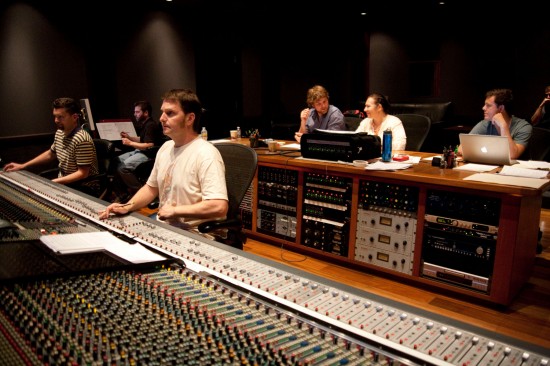 [7]
[7]
[Kouneva and team in the recording studio – photo courtesy Lisa Bevis [8]]
First of all, this album’s opener “Waiting for Dawn to Break” is nothing short of perfect. It captures the kind of intensity before the storm of war that is applicable to all time periods: the modern gun-toting soldier and then sword-and-spear-wielding warriors of ancient days as well. The music also combines traditional orchestra with some modern electronic and rock-infused instruments. The use of xylophone at the track’s end is also brilliant.
The first of the three “movements” to this album starts up with a song that bears some similarities with FFVII’s classic “Bombing Mission.” Namely, it’s a fast-paced 6/8 piece with a focus on booming drums and pulsating rhythmic patterns with the tone-producing instruments. The brass is powerful, and the strings switch off from staccato to big sweeps of smooth legato. Then we have the first of two “Mission Fail” tracks. This first track opens with piano, guitar and ethereal synths. It builds into a surprisingly upbeat piece of music, though the melody stays in a somber minor key most of the time. I think it’s interesting that a song meant to represent failure, loss, or setback could be written in this way. But let me assure you: it works.
We then come to a three-part “Soldier’s Odyssey” across two tracks. The opening and ending sections are times to mourn loss. We have “At a Soldier’s Grave” and “Flowers at a Monument.” The titles are meant to evoke sorrow and frustration and pain, but I think even without the track titles, these sentiments are properly brought to light with the music itself. The only part of the song that demonstrates activity is “Engaging the Enemy” in the middle. It’s a brief but powerful bit of orchestral music. There are even sound effects of war: choppers, sirens, explosions, and more.
“Sniper Attack” is a short, intense orchestral piece. By this point I want to say “I’ve had enough.” Fortunately this song doesn’t overstay its welcome, and we’ve almost reached my favorite part of the album. But before that, we get a short (100-second) synth-laden choppy dubstep piece, “Confrontation from a Lo-Fi Dimension.” It serves as a fun transition, and is almost definitely Kouneva’s pitch for “trailer music” for whatever project she lands next. It’s certainly fitting.
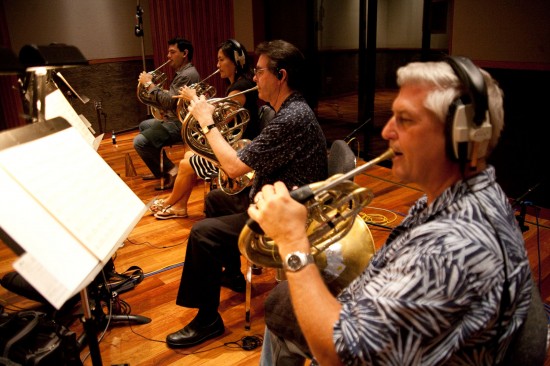 [9]
[9]
[French Horns: the “cowbell” of orchestra. i.e. — “I need more French Horn!” – photo courtesy Lisa Bevis [8]]
But now we start on the second movement: “Faraway Lands, Ancient Times.” It is without a doubt my favorite part of the album. Unfortunately, it’s also the shortest section. The four songs combine to only 8 or 9 minutes of music across the 48 minutes of audio. But I love this stuff. I like the soundtracks for the God of War series, sure. But there was too much guitar in it for me. I wanted a more authentic ancient sound. Considering Kouneva’s work on the recent Prince of Persia games, it seems she is well-suited to work with the instruments and styles of the Mediterranean and Arabic Middle East.
And all of the work here is more than just suitable. It’s beautiful. I especially love the action and movement in “Chase Through Crete” and the serenity of “Between Eden and Distant Fields.” What is this? Game score? Film score? Technically it’s neither, but it’d be great for both. I guess that’s why the term “media score” has gained so much traction. Forgive me for the aside.
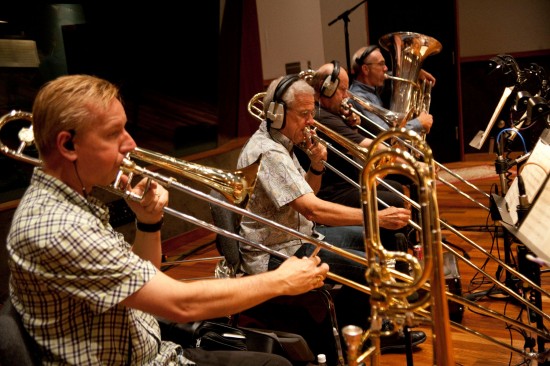 [10]
[10]
[Booming brass: you can’t have “war music” without it – photo courtesy Lisa Bevis [8]]
So we’ve had the modern soldier and the ancient battles. What’s next? More modern stuff, actually, but this time there’s a focus on flying instead of ground troops. If I had to guess based on the sensibilities of most gamers, especially those drawn to FPS’s, this would probably be *their* favorite of the three movements. It is not mine, but I still found plenty to appreciate in it.
For example, “The Wanderer.” This is a beautiful piano and strings instrumental ballad. Simple, traditional, calming. I am a sucker for that sound, and Kouneva nails it. These songs are even more powerful, in my opinion, when nestled amongst intense fighting music. It’s important to remember that most people in the history of war have believed they are fighting *for* something or someone. And regardless of the morality or confusion behind such motivation, the fact is that for those people, in those moments, it’s a powerful feeling.
Such feelings continue to haunt us and hurt us, as war is nothing if it is not without sacrifice. “Mission Fail 2 and Requiem” lives up to its song title. It is appropriately sorrowful, even so dark as to be hopeless. There is no lifting out of this. The dissonant chords in the treble piano at the end are fully haunting.
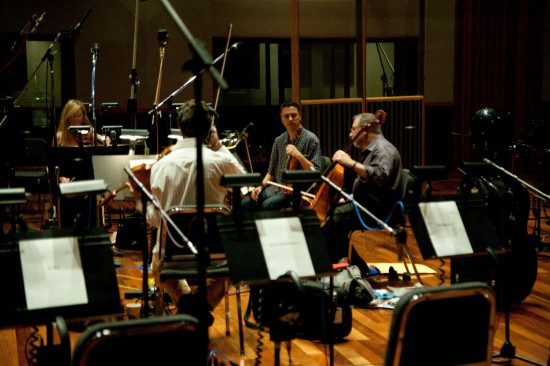 [11]
[11]
[String sections are notoriously the worst rhythm-keepers in any given orchestra; these performers, however, are spot on with the tight rhythm and tempo of each song – photo courtesy Lisa Bevis [8]]
And yet, we don’t end on this note. The finale, “Airplane Bound for the Skies,” suggests that people do somehow overcome and find peace at the end of war. It starts with one single violin, then a string ensemble, which then meets up with an entire orchestra and a variety of synths and sound effects. There’s also an almost celebratory percussion line in the final minute of the piece.
Concluding thought: I don’t think this kind of music would have worked for any one game. And for this reason, I’m glad Ms. Kouneva had the opportunity to write music for no other reason than to create music. I think it’s a great display of her own talents and a reminder that the training ground for “scoring” need not be limited to projects that have visuals in-place.
For more background on Kouneva, I’d also recommend checking out an interview that Kouneva did with SEMO [12] in 2010. It’s a great read!
Purchase CD – Howlin’ Wolf Records [2]
Purchase Digital – Amazon MP3 [3] | iTunes [4]
